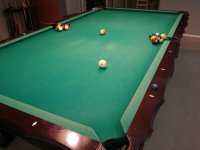Distance is what kills me.
Short distance (cb to ob, ob to pocket) straight-in's are not that tough. You can also manipulate the cb with a little cheating of pocket.
LONG STRAIGHT-IN'S: (3/4 table length, cb to ob): Tough for me. Any deviation from center, or more than accounted for....I miss or rattle too often. Add attempting to juice the cb...a real crap shoot.
Probably wrong, but for me these long ones have to be hit much more pure than cuts.
Cuts often have some built in miss tolerance, be it, cut induced pocketing english, speed considerations, natural shape routes after the hit, etc.
I practice them, do ok, but don't like em, especially if additional speed is involved for shape.
Guess that's why we like to leave angles.
